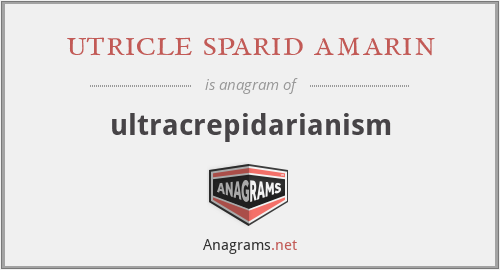What anagrams are available for ultracrepidarianism?
This page is about an anagram for the word utricle sparid amarin that can be used in word games, puzzles, trivia and other crossword based board games.
utricle sparid amarin
Translation
Find a translation for utricle sparid amarin in other languages:
Select another language:
- - Select -
- 简体中文 (Chinese - Simplified)
- 繁體中文 (Chinese - Traditional)
- Español (Spanish)
- Esperanto (Esperanto)
- 日本語 (Japanese)
- Português (Portuguese)
- Deutsch (German)
- العربية (Arabic)
- Français (French)
- Русский (Russian)
- ಕನ್ನಡ (Kannada)
- 한국어 (Korean)
- עברית (Hebrew)
- Gaeilge (Irish)
- Українська (Ukrainian)
- اردو (Urdu)
- Magyar (Hungarian)
- मानक हिन्दी (Hindi)
- Indonesia (Indonesian)
- Italiano (Italian)
- தமிழ் (Tamil)
- Türkçe (Turkish)
- తెలుగు (Telugu)
- ภาษาไทย (Thai)
- Tiếng Việt (Vietnamese)
- Čeština (Czech)
- Polski (Polish)
- Bahasa Indonesia (Indonesian)
- Românește (Romanian)
- Nederlands (Dutch)
- Ελληνικά (Greek)
- Latinum (Latin)
- Svenska (Swedish)
- Dansk (Danish)
- Suomi (Finnish)
- فارسی (Persian)
- ייִדיש (Yiddish)
- հայերեն (Armenian)
- Norsk (Norwegian)
- English (English)
Definition
What does ultracrepidarianism mean?
- ultracrepidarianism
- Sutor, ne ultra crepidam is a Latin expression meaning literally 'Shoemaker, not beyond the shoe', used to warn individuals not to pass judgment beyond their expertise. The expression led to the term ultracrepidarianism, which is the giving of opinions and advice on matters outside of one's knowledge. Its origin is set down in Pliny the Elder's Naturalis Historia [35.85 (Loeb IX, 323–325)] where he records that a shoemaker (sutor) had approached the painter Apelles of Kos to point out a defect in the artist's rendition of a sandal (crepida from Greek krepis), which Apelles duly corrected. Encouraged by this, the shoemaker then began to enlarge on other defects he considered present in the painting, at which point Apelles advised him that ne supra crepidam sutor iudicaret ('a shoemaker should not judge beyond the shoe'), which advice, Pliny observed, had become a proverbial saying. The Renaissance interest both in painting and classical antiquity made the expression popular again.The saying remains popular in several languages, as in the English "A cobbler should stick to his last", the Dutch Schoenmaker, blijf bij je leest, the Danish Skomager, bliv ved din læst, the German Schuster, bleib bei deinen Leisten, and the Polish Pilnuj, szewcze, kopyta. Other languages use slightly changed forms: the Spanish Zapatero, a tus zapatos ('Shoemaker, [tend] to your shoes'), and the Russian Суди, дружок, не свыше сапога ('Judge not, pal, above the boot'), after Alexander Pushkin's poetic retelling of the legend.Karl Marx ridiculed the idea: "'Ne sutor ultra crepidam' – this nec plus ultra of handicraft wisdom became sheer nonsense, from the moment the watchmaker Watt invented the steam-engine, the barber Arkwright the throstle, and the working-jeweller Fulton the steamship."
Embed
Citation
Use the citation below to add this anagram to your bibliography:
Style:MLAChicagoAPA
"utricle sparid amarin." Anagrams.net. STANDS4 LLC, 2024. Web. 8 May 2024. <https://www.anagrams.net/term/15294177>.



Discuss this ultracrepidarianism anagram with the community:
Report Comment
We're doing our best to make sure our content is useful, accurate and safe.
If by any chance you spot an inappropriate comment while navigating through our website please use this form to let us know, and we'll take care of it shortly.
Attachment
You need to be logged in to favorite.
Log In